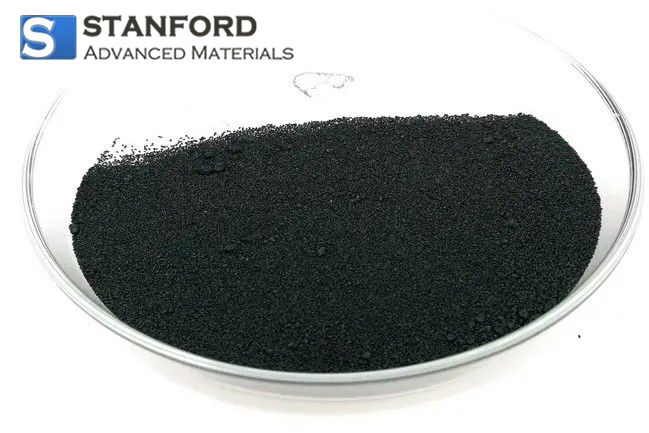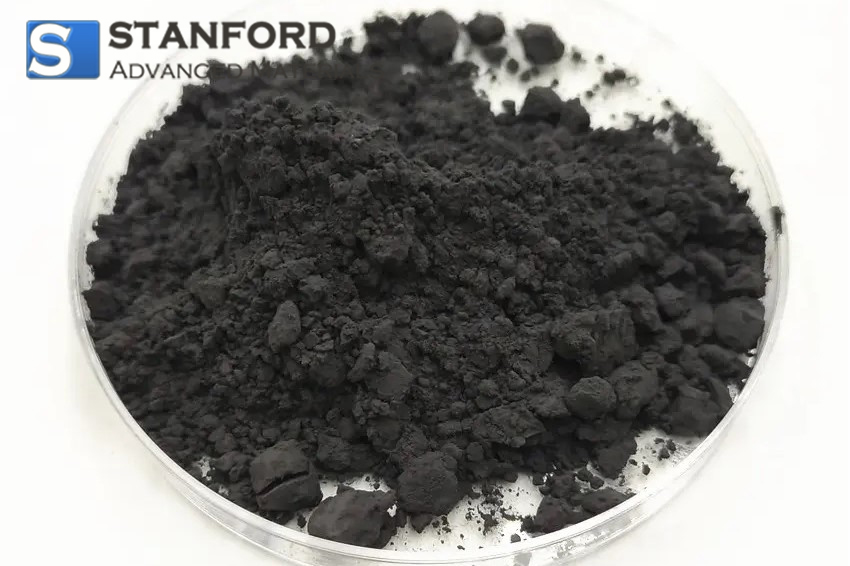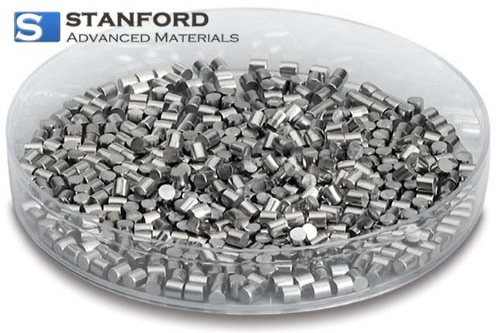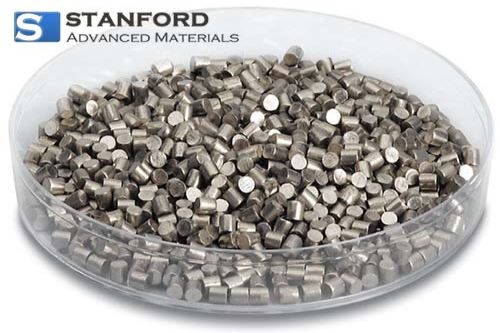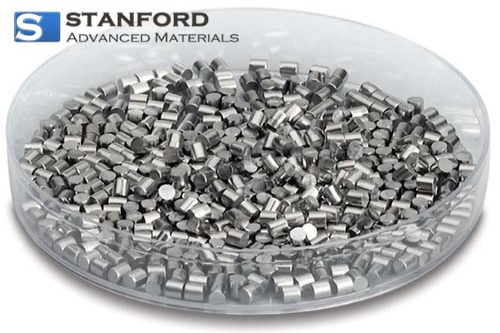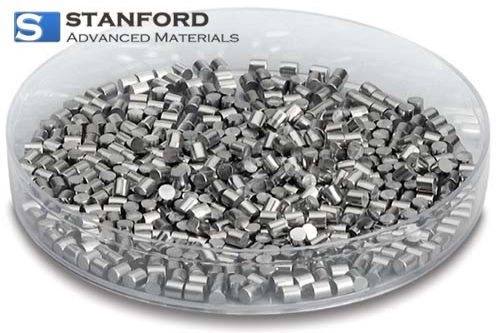SECTION 1. IDENTIFICATION
Product Name: Potassium Hexacyanocobaltate(III)
CAS #: 13963-58-1
Relevant identified uses of the substance: Scientific research and development
Supplier details:
Stanford Advanced Materials
E-mail: sales@samaterials.com
Tel: (949) 407-8904
Address: 23661 Birtcher Dr., Lake Forest, CA 92630 U.S.A.
SECTION 2. HAZARDS IDENTIFICATION
Classification of the substance or mixture
Classification according to Regulation (EC) No 1272/2008
GHS06 Skull and crossbones
Acute Tox. 3 H311 Toxic in contact with skin.
GHS08 Health hazard
Carc. 2 H351 Suspected of causing cancer.
GHS07
Acute Tox. 4 H302 Harmful if swallowed.
Acute Tox. 4 H332 Harmful if inhaled.
Skin Sens. 1 H317 May cause an allergic skin reaction.
Hazards not otherwise classified
No data available
Label elements
Labelling according to Regulation (EC) No 1272/2008
The substance is classified and labeled according to the CLP regulation.
Hazard pictogramsGHS06 GHS08
Signal word: Danger
Hazard statements
H302+H332 Harmful if swallowed or if inhaled.
H311 Toxic in contact with skin.
H317 May cause an allergic skin reaction.
H351 Suspected of causing cancer.
Precautionary statements
P261 Avoid breathing dust/fume/gas/mist/vapors/spray.
P280 Wear protective gloves/protective clothing/eye protection/face protection.
P281 Use personal protective equipment as required.
P361 Remove/Take off immediately all contaminated clothing.
P405 Store locked up.
P501 Dispose of contents/container in accordance with local/regional/national/international
regulations.
WHMIS classification
D1B - Toxic material causing immediate and serious toxic effects
D2A - Very toxic material causing other toxic effects
Classification system
HMIS ratings (scale 0-4)
(Hazardous Materials Identification System)
HEALTH
FIRE
REACTIVITY
2
0
1
Health (acute effects) = 2
Flammability = 0
Physical Hazard = 1
Other hazards
Results of PBT and vPvB assessment
PBT: N/A
vPvB: N/A
SECTION 3. COMPOSITION/INFORMATION ON INGREDIENTS
Substances
CAS No. / Substance Name:
13963-58-1 Potassium hexacyanocobaltate (III)
Identification number(s):
EC number: 237-742-1
SECTION 4. FIRST AID MEASURES
Description of first aid measures
If inhaled:
Supply patient with fresh air. If not breathing, provide artificial respiration. Keep patient warm.
Seek immediate medical advice.
In case of skin contact:
Immediately wash with soap and water; rinse thoroughly.Seek immediate medical advice.
In case of eye contact:
Rinse opened eye for several minutes under running water. Consult a physician.
If swallowed:
Seek medical treatment.
Information for doctor
Most important symptoms and effects, both acute and delayed
No data available
Indication of any immediate medical attention and special treatment needed
No data available
SECTION 5. FIREFIGHTING MEASURES
Extinguishing media
Suitable extinguishing agents
Product is not flammable. Use fire-fighting measures that suit the surrounding fire.
Special hazards arising from the substance or mixture
If this product is involved in a fire, the following can be released:
Hydrogen cyanide (HCN)
Nitrogen oxides (NOx)
Carbon monoxide and carbon dioxide
Advice for firefighters
Protective equipment:
Wear self-contained respirator.
Wear fully protective impervious suit.
SECTION 6. ACCIDENTAL RELEASE MEASURES
Personal precautions, protective equipment and emergency procedures
Use personal protective equipment. Keep unprotected persons away.
Ensure adequate ventilation
Environmental precautions:
Do not allow material to be released to the environment without official permits.
Methods and materials for containment and cleanup:
Dispose of contaminated material as waste according to section 13.
Ensure adequate ventilation.
Prevention of secondary hazards:
No special measures required.
Reference to other sections
See Section 7 for information on safe handling
See Section 8 for information on personal protection equipment.
See Section 13 for disposal information
SECTION 7. HANDLING AND STORAGE
Handling
Precautions for safe handling
Keep container tightly sealed.
Store in cool, dry place in tightly closed containers.
Ensure good ventilation at the workplace.Information about protection against explosions and fires:
The product is not flammable
Conditions for safe storage, including any incompatibilities
Requirements to be met by storerooms and receptacles:
No special requirements.
Information about storage in one common storage facility:
Store away from oxidizing agents.
Do not store together with acids.
Further information about storage conditions:
Keep container tightly sealed.
Store in cool, dry conditions in well-sealed containers.
Specific end use(s)
No data available
SECTION 8. EXPOSURE CONTROLS/PERSONAL PROTECTION
Additional information about design of technical systems:
Properly operating chemical fume hood designed for hazardous chemicals and having an average
face velocity of at least 100 feet per minute.
Control parameters
Components with limit values that require monitoring at the workplace:
Cyanides (as CN)
mg/m3
Austria MAK 5 (skin)
Denmark TWA 5 (skin)
Finland TWA 5; 10-STEL
France VME 5 (skin)
Germany MAK 5 (skin)
Hungary TWA 0.3; 0.6-STEL (skin)
Netherlands MAC-TGG 5 (skin)
Poland TWA 0.3; 10-Ceiling
Sweden 5-Ceiling (skin)
Switzerland MAK-W 5; 10-STEL (skin)
United Kingdom 5-LTEL (skin)
OSHA PEL 5 (skin)
Cobalt, elemental & inorganic compounds, as Co
mg/m3
ACGIH TLV 0.02; Confirmed animal carcinogen
Austria Carcinogen
Belgium TWA 0.05
Denmark TWA 0.05
Finland TWA 0.05 (skin)
Germany Carcinogen
Hungary TWA 0.1; 0.2-STEL
Japan OEL 0.05; 2B-Carcinogen
Korea TLV 0.02; Confirmed animal carcinogen
Netherlands MAC-TGG 0.05
Norway TWA 0.05
Poland TWA 0.05; 0.2-STEL
Russia 0.5-STEL
Sweden NGV 0.05
Switzerland MAK-W 0.1; Carcinogen
United Kingdom TWA 0.1USA PEL 0.1 (dust and fume)
Additional information: No data
Exposure controls
Personal protective equipment
Follow typical protective and hygienic practices for handling chemicals.
Keep away from foodstuffs, beverages and feed.
Remove all soiled and contaminated clothing immediately.
Wash hands before breaks and at the end of work.
Avoid contact with the eyes and skin.
Maintain an ergonomically appropriate working environment.
Breathing equipment:
Use suitable respirator when high concentrations are present.
Protection of hands:
Impervious gloves
Inspect gloves prior to use.
Suitability of gloves should be determined both by material and quality, the latter of which may vary by
manufacturer.
Eye protection: Safety glasses
Body protection: Protective work clothing.
SECTION 9. PHYSICAL AND CHEMICAL PROPERTIES
Information on basic physical and chemical properties
Appearance:
Form: Powder
Color: Light yellow
Odor: Odorless
Odor threshold: No data available.
pH: N/A
Melting point/Melting range: No data available
Boiling point/Boiling range: No data available
Sublimation temperature / start: No data available
Flash point: N/A
Flammability (solid, gas): No data available.
Ignition temperature: No data available
Decomposition temperature: No data available
Autoignition: No data available.
Danger of explosion:
Product does not present an explosion hazard.
Explosion limits:
Lower: No data available
Upper: No data available
Vapor pressure: N/A
Density at 20 °C (68 °F): 1.906 g/cm
3
(15.906 lbs/gal)
Relative density: No data available.
Vapor density: N/A
Evaporation rate: N/A
Solubility in Water (H
2
O): Soluble
Partition coefficient (n-octanol/water): No data available.
Viscosity:
Dynamic: N/A
Kinematic: N/A
Other informationNo data available
SECTION 10. STABILITY AND REACTIVITY
Reactivity
No data available
Chemical stability
Stable under recommended storage conditions.
Thermal decomposition / conditions to be avoided:
Decomposition will not occur if used and stored according to specifications.
Possibility of hazardous reactions
No dangerous reactions known
Conditions to avoid
No data available
Incompatible materials:
Oxidizing agents
Acids
Hazardous decomposition products:
Hydrogen cyanide
Carbon monoxide and carbon dioxide
Nitrogen oxides
SECTION 11. TOXICOLOGICAL INFORMATION
Information on toxicological effects
Acute toxicity:
Harmful if inhaled.
Harmful if swallowed.
Toxic in contact with skin.
Danger through skin absorption.
LD/LC50 values that are relevant for classification: Oral LD50 1529 mg/kg (mouse)
Skin irritation or corrosion: Irritant to skin and mucous membranes.
Eye irritation or corrosion: Irritating effect.
Sensitization: May cause an allergic skin reaction.
Germ cell mutagenicity: No effects known.
Carcinogenicity: Suspected of causing cancer.
Reproductive toxicity: No effects known.
Specific target organ system toxicity - repeated exposure: No effects known.
Specific target organ system toxicity - single exposure: No effects known.
Aspiration hazard: No effects known.
Subacute to chronic toxicity:
Cobalt is an experimental neoplastigen and tumorigen. It is an experimental carcinogen of the
connective tissue and lungs. Cobalt metal and inorganic compounds are classified as an animal
carcinogen by the ACGIH. Ingestion may cause burning in the mouth, esophagus, and stomach.
Inhalation of dusts and fumes may cause irritation of the respiratory tract and labored breathing and
coughing. Sensitization, nausea, flushing of the face and ringing in the ears is also possible.
Chronic ingestion may result in pericardial effusion, polycardial effusion, polycythemia, cardiac failure,
vomiting, convulsions and thyroid enlargement.
Cyanides may cause symptoms of salivation, nausea without vomiting, anxiety, confusion, vertigo,
giddiness, lower jaw stiffness, convulsions, opisthotonos, paralysis, coma, cardiac arrhythmias and
respiratory failure. They typically cause death through asphyxia. Skin contact may cause itching,macular, papular and vesicular eruptions.
Subacute to chronic toxicity: No effects known.
Additional toxicological information:
To the best of our knowledge the acute and chronic toxicity of this substance is not fully known.
Carcinogenic categories
OSHA-Ca (Occupational Safety & Health Administration)
Substance is not listed.
SECTION 12. ECOLOGICAL INFORMATION
Toxicity
Aquatic toxicity:
No data available
Persistence and degradability
No data available
Bioaccumulative potential
No data available
Mobility in soil
No data available
Additional ecological information:
Do not allow material to be released to the environment without official permits.
Do not allow undiluted product or large quantities to reach groundwater, water courses, or sewage
systems.
Avoid transfer into the environment.
Results of PBT and vPvB assessment
PBT: N/A
vPvB: N/A
Other adverse effects
No data available
SECTION 13. DISPOSAL CONSIDERATIONS
Waste treatment methods
Recommendation
Consult official regulations to ensure proper disposal.
Uncleaned packagings:
Recommendation:
Disposal must be made according to official regulations.
Recommended cleansing agent:
Water, if necessary with cleansing agents.
SECTION 14. EXPOSURE CONTROLS/PERSONAL PROTECTION
Not a hazardous material for transportation.
UN-Number
DOT, IMDG, IATA
None
UN proper shipping name
DOT, IMDG, IATA
NoneTransport hazard class(es)
DOT, ADR, IMDG, IATA
Class
None
Packing group
DOT, IMDG, IATA
None
Environmental hazards:
N/A
Special precautions for user
N/A
Transport in bulk according to Annex II of MARPOL73/78 and the IBC Code
N/A
Transport/Additional information:
Not dangerous according to the above specifications.
DOT
Marine Pollutant (DOT):
No
SECTION 15. REGULATORY INFORMATION
Safety, health and environmental regulations/legislation specific for the substance or mixture
National regulations
All components of this product are listed in the U.S. Environmental Protection Agency Toxic
Substances Control Act Chemical substance Inventory.
All components of this product are listed on the Canadian Non-Domestic Substances List (NDSL).
SARA Section 313 (specific toxic chemical listings)
13963-58-1 Potassium hexacyanocobaltate (III)
California Proposition 65
Prop 65 - Chemicals known to cause cancer
Substance is not listed
Prop 65 - Developmental toxicity
Substance is not listed.
Prop 65 - Developmental toxicity, female
Substance is not listed.
Prop 65 - Developmental toxicity, male
13963-58-1 Potassium hexacyanocobaltate (III)
Information about limitation of use:
For use only by technically qualified individuals.
This product contains cobalt and is subject to the reporting requirements of section 313 of the
Emergency Planning and Community Right to Know Act of 1986 and
40CFR372.
This product is subject to the reporting requirements of section 313 of the Emergency Planning and
Community Right to Know Act of 1986 and 40CFR372.
This product contains a cyanide compound and is subject to the reporting requirements of section 313
of the Emergency Planning and Community Right to Know Act of 1986 and 40CFR372.
Other regulations, limitations and prohibitive regulations
Substance of Very High Concern (SVHC) according to the REACH Regulations (EC) No. 1907/2006.
Substance is not listed.
The conditions of restrictions according to Article 67 and Annex XVII of the Regulation (EC) No
1907/2006 (REACH) for the manufacturing, placing on the market and use must be observed.
Substance is not listed.
Annex XIV of the REACH Regulations (requiring Authorisation for use)Substance is not listed.
Chemical safety assessment:
A Chemical Safety Assessment has not been carried out
SECTION 16. OTHER INFORMATION
Safety Data Sheet according to Regulation (EC) No. 1907/2006 (REACH). The above information is
believed to be correct but does not purport to be all inclusive and shall be used only as a guide. The
information in this document is based on the present state of our knowledge and is applicable to the
product with regard to appropriate safety precautions. It does not represent any guarantee of the
properties of the product.


 English
English Española
Española Deutsch
Deutsch Français
Français Italiano
Italiano
 GHS07
GHS07